at TA = 25°C, VS+ = 2.5 V, VS– = –2.5 V, VIN+ = 0 V, Gain = 1 V/V, RF = 0 Ω, RL = 200 Ω, and output load referenced to midsupply (unless otherwise noted)

| VOUT = 100 mVPP; see Section 7 for circuit configuration |
Figure 6-1 Small-Signal Frequency Response vs Gain Figure 6-3 Small-Signal Frequency Response vs Output Load
Figure 6-3 Small-Signal Frequency Response vs Output Load Figure 6-5 Frequency Response at Gain = 20 V/V
Figure 6-5 Frequency Response at Gain = 20 V/V Figure 6-7 Large-Signal Frequency Response vs Gain
Figure 6-7 Large-Signal Frequency Response vs Gain Figure 6-9 Closed-Loop Output Impedance vs Frequency
Figure 6-9 Closed-Loop Output Impedance vs Frequency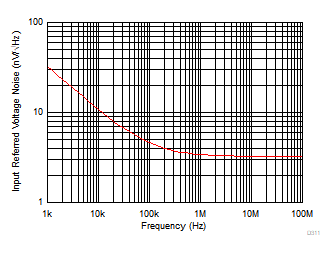 Figure 6-11 Voltage Noise Density vs Frequency
Figure 6-11 Voltage Noise Density vs Frequency Figure 6-13 Harmonic Distortion (HD2) vs Output Swing
Figure 6-13 Harmonic Distortion (HD2) vs Output Swing Figure 6-15 Harmonic Distortion (HD2) vs Output Load
Figure 6-15 Harmonic Distortion (HD2) vs Output Load Figure 6-17 Harmonic Distortion (HD2) vs Gain
Figure 6-17 Harmonic Distortion (HD2) vs Gain
| Average Rise and Fall Time (10% - 90%) = 450 ps |
Figure 6-19 Small-Signal Transient Response Figure 6-21 Small-Signal Transient Response vs Capacitive Load
Figure 6-21 Small-Signal Transient Response vs Capacitive Load Figure 6-23 Turnon Transient Response
Figure 6-23 Turnon Transient Response Figure 6-25 Common-Mode Rejection Ratio vs Frequency
Figure 6-25 Common-Mode Rejection Ratio vs Frequency Figure 6-27 Quiescent Current vs Supply Voltage
Figure 6-27 Quiescent Current vs Supply Voltage Figure 6-29 Quiescent Current (Amplifier Disabled) vs Ambient Temperature
Figure 6-29 Quiescent Current (Amplifier Disabled) vs Ambient Temperature
| µ = –2.1
µV/°C |
σ = 2
µV/°C |
32 Units
Tested |
Figure 6-31 Offset Voltage vs Ambient Temperature Figure 6-33 Offset Voltage vs Input Common-Mode Voltage vs Ambient Temperature
Figure 6-33 Offset Voltage vs Input Common-Mode Voltage vs Ambient Temperature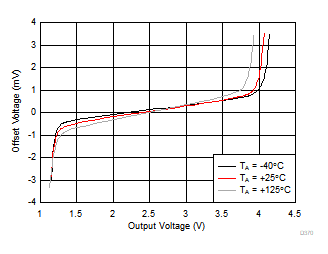 Figure 6-35 Offset Voltage vs Output Swing vs Ambient Temperature
Figure 6-35 Offset Voltage vs Output Swing vs Ambient Temperature Figure 6-37 Input
Bias Current vs Input Common-Mode Voltage
Figure 6-37 Input
Bias Current vs Input Common-Mode Voltage Figure 6-39 Output Swing vs Sourcing Current
Figure 6-39 Output Swing vs Sourcing Current
| µ = –0.38
mV |
σ = 0.97
mV |
9150 Units
Tested |
Figure 6-41 Offset Voltage Distribution Figure 6-2 Small-Signal Frequency Response vs Supply Voltage
Figure 6-2 Small-Signal Frequency Response vs Supply Voltage Figure 6-4 Small-Signal Frequency Response vs Ambient Temperature
Figure 6-4 Small-Signal Frequency Response vs Ambient Temperature
| VOUT = 100 mVPP, See Figure 7-4 for circuit configuration |
Figure 6-6 Small-Signal Frequency Response vs Capacitive Load Figure 6-8 Large-Signal Response for 0.1-dB Gain Flatness
Figure 6-8 Large-Signal Response for 0.1-dB Gain Flatness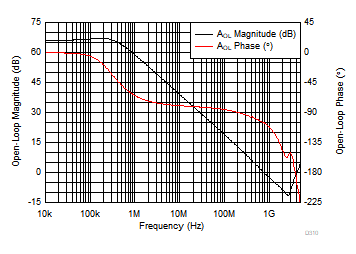 Figure 6-10 Open-Loop Magnitude and Phase vs Frequency
Figure 6-10 Open-Loop Magnitude and Phase vs Frequency Figure 6-12 Voltage Noise Density vs Ambient Temperature
Figure 6-12 Voltage Noise Density vs Ambient Temperature Figure 6-14 Harmonic Distortion (HD3) vs Output Swing
Figure 6-14 Harmonic Distortion (HD3) vs Output Swing Figure 6-16 Harmonic Distortion (HD3) vs Output Load
Figure 6-16 Harmonic Distortion (HD3) vs Output Load Figure 6-18 Harmonic Distortion (HD3) vs Gain
Figure 6-18 Harmonic Distortion (HD3) vs Gain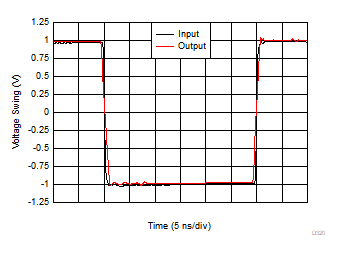
| Slew
Rate: Falling = 1160 V/µs, Rising = 1400 V/µs |
Figure 6-20 Large-Signal Transient Response
| Gain
= 5 V/V, RF = 453 Ω, 2x Output
Overdrive |
Figure 6-22 Output Overload Response Figure 6-24 Turnoff Transient Response
Figure 6-24 Turnoff Transient Response Figure 6-26 Power
Supply Rejection Ratio vs Frequency
Figure 6-26 Power
Supply Rejection Ratio vs Frequency Figure 6-28 Quiescent Current vs Ambient Temperature
Figure 6-28 Quiescent Current vs Ambient Temperature Figure 6-30 Offset Voltage vs Supply Voltage
Figure 6-30 Offset Voltage vs Supply Voltage Figure 6-32 Offset Voltage vs Input Common-Mode Voltage
Figure 6-32 Offset Voltage vs Input Common-Mode Voltage Figure 6-34 Offset Voltage vs Output Swing
Figure 6-34 Offset Voltage vs Output Swing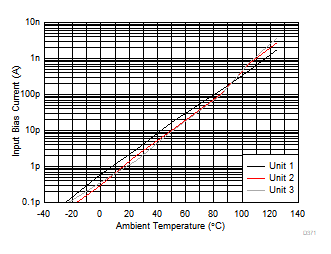 Figure 6-36 Input
Bias Current vs Ambient Temperature
Figure 6-36 Input
Bias Current vs Ambient Temperature Figure 6-38 Output Swing vs Sinking Current
Figure 6-38 Output Swing vs Sinking Current
| µ = 20.8
mA |
σ = 0.25
mA |
9150 Units
Tested |
Figure 6-40 Quiescent Current Distribution
| µ = –0.55
pA |
σ = 0.23
pA |
9150 Units
Tested |
Figure 6-42 Input
Bias Current Distribution








































